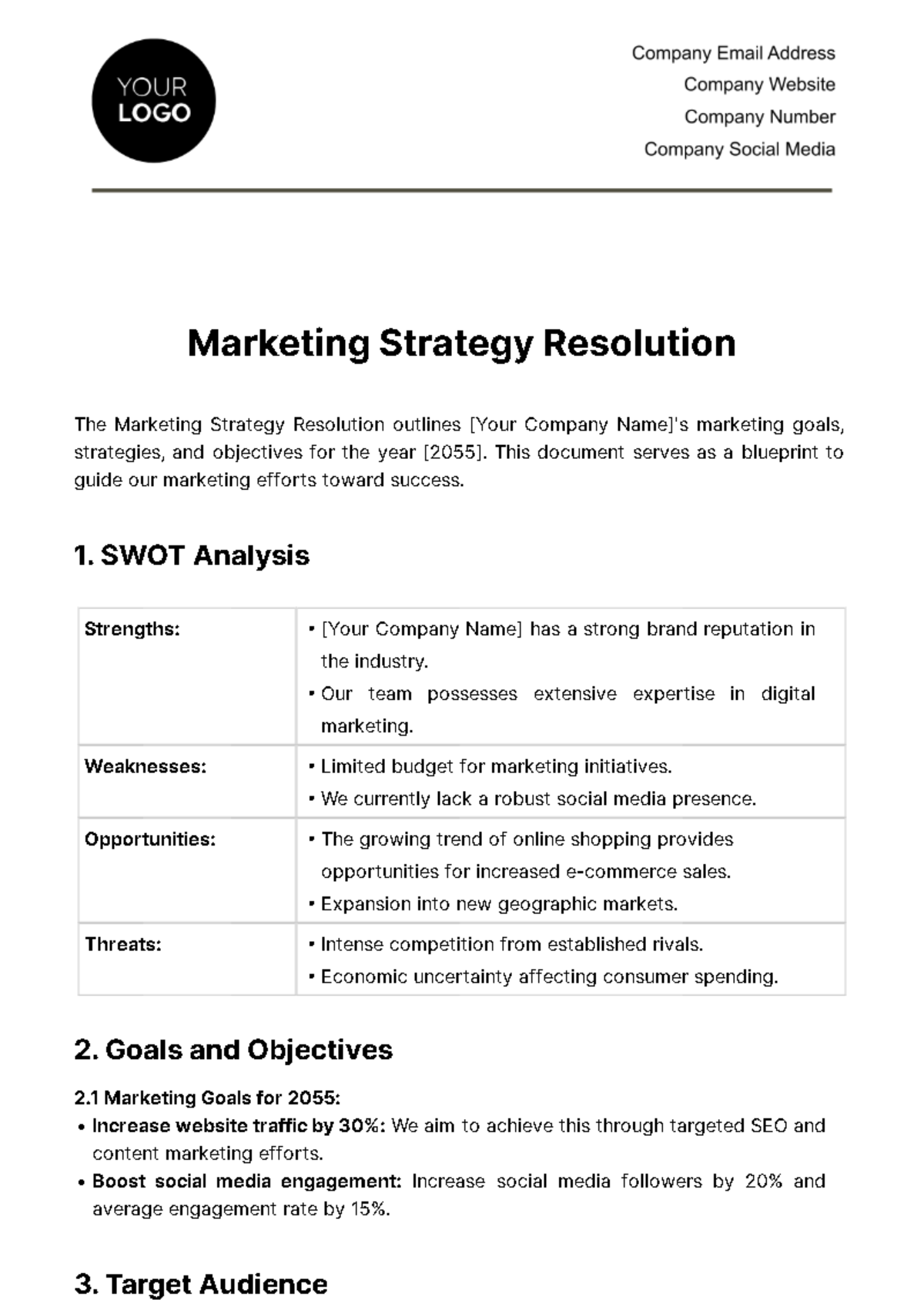Free Marketing Strategy Resolution

The Marketing Strategy Resolution outlines [Your Company Name]'s marketing goals, strategies, and objectives for the year [2055]. This document serves as a blueprint to guide our marketing efforts toward success.
1. SWOT Analysis
Strengths: |
|
Weaknesses: |
|
Opportunities: |
|
Threats: |
|
2. Goals and Objectives
2.1 Marketing Goals for 2055:
Increase website traffic by 30%: We aim to achieve this through targeted SEO and content marketing efforts.
Boost social media engagement: Increase social media followers by 20% and average engagement rate by 15%.
3. Target Audience
3.1 Description:
Our primary target audience consists of tech-savvy millennials aged 25-34, interested in sustainable living and urban mobility.
4. Marketing Strategies
4.1 Strategy 1: Content Marketing
Description: | Content marketing will focus on providing valuable guides and articles related to sustainable living and urban mobility. |
Key Tactics: |
|
Budget Allocation: |
|
4.2 Strategy 2: Social Media Advertising
Description: | Leveraging paid advertising on platforms like Facebook and Instagram to reach our target audience. |
Key Tactics: |
|
Budget Allocation: |
|
5. Content Plan
5.1 Content Types: Our content plan includes blog posts, videos, infographics, and email newsletters.
5.2 Content Calendar:
Month | Content Topic | Publish Date |
January | "Top Sustainable Commutes" | January 15, 2055 |
February | "Urban Mobility Challenges" | February 10, 2055 |
March | "Eco-Friendly Transportation Options" | March 5, 2055 |
April | "Green Cities: The Future of Urban Living" | April 12, 2055 |
May | "Reducing Carbon Footprint: Tips for Urban Dwellers" | May 20, 2055 |
June | "Electric Scooters: The Smart Way to Commute" | June 8, 2055 |
July | "Sustainable Transportation: Trends and Innovations" | July 15, 2055 |
August | "Cycling for a Greener Tomorrow" | August 10, 2055 |
September | "Public Transportation and Environmental Impact" | September 9, 2055 |
October | "Smart Cities and Sustainable Mobility" | October 7, 2055 |
November | "The Role of Technology in Urban Mobility" | November 12, 2055 |
December | "Year in Review: Sustainable Urban Mobility Highlights" | December 20, 2055 |
6. Budget and Resources
6.1 Budget Allocation:
Total Marketing Budget for 2055: $80,000
6.2 Resources:
Personnel:
Marketing Manager: Sarah Smith
Content Writer: David Johnson
Social Media Specialist: Emily Davis
Tools and Software:
Google Analytics
MailChimp
Facebook Ads Manager
SEMrush (for SEO analysis)
7. Timeline and Milestones
Q1 2055: |
|
Q2 2055: |
|
Q3 2055: |
|
Q4 2055: |
|
8. Measurement and Analytics
8.1 Key Performance Indicators (KPIs):
Website Traffic (Google Analytics)
Social Media Engagement (Facebook Insights)
8.2 Tools:
We will use Google Analytics and Facebook Insights to track and analyze marketing performance.
9. Risk Management
9.1 Risks:
Budget constraints may limit campaign effectiveness.
Market shifts impacting urban mobility trends.
9.2 Mitigation Strategies:
Monitor the budget closely and make adjustments as necessary.
Stay agile and adapt marketing strategies based on market changes.
10. Reporting and Evaluation
10.1 Reporting Frequency:
We will provide monthly progress reports and quarterly comprehensive assessments.
10.2 Evaluation:
Monthly reports will analyze KPI performance, while quarterly assessments will measure goal achievement and propose adjustments if needed.
11. Conclusion and Commitment
At [Your Company Name], we wholeheartedly commit to the successful execution of this marketing strategy. Our dedication to achieving our goals and objectives for the year [2055] is unwavering. We are driven by our passion for sustainable urban mobility and our desire to make a positive impact in this field. With a cohesive team and a well-structured plan, we are confident that we will not only meet but exceed our targets, bringing us closer to a greener and more sustainable future.
12. Appendices
In the appendices section, you can find a wealth of supplementary materials that fortify this resolution. These include:
Market Research Report
Competitor Analysis
Content Calendar
Budget Breakdown
Monthly Progress Reports
- 100% Customizable, free editor
- Access 1 Million+ Templates, photo’s & graphics
- Download or share as a template
- Click and replace photos, graphics, text, backgrounds
- Resize, crop, AI write & more
- Access advanced editor
Revolutionize your marketing approach with the Marketing Strategy Resolution Template by Template.net. Crafted for flexibility, this editable and customizable resource empowers you to tailor strategies effortlessly. Seamlessly editable in our Ai Editor Tool, it offers a dynamic framework to drive your marketing resolutions forward with precision and innovation.
You may also like
- Marketing Google Slide
- Marketing Letter
- Marketing Quotation
- Marketing Report
- Marketing Strategic Plan
- Marketing Plan
- Marketing Proposal
- Marketing Flyer
- Marketing Presentation
- Real Estate Marketing Plan
- Marketing Contract
- Marketing Agreement
- Marketing Resume
- Marketing Checklist
- Marketing Brochure
- Marketing Banner
- Marketing Schedule
- Marketing Vector
- Marketing Logo
- Marketing Chart
- Marketing Campaign Plan
- Marketing Budget
- Marketing Postcard
- Marketing Poster
- Marketing Facebook Post
- Marketing Instagram Post
- Marketing Newsletter
- Marketing Infographic





























